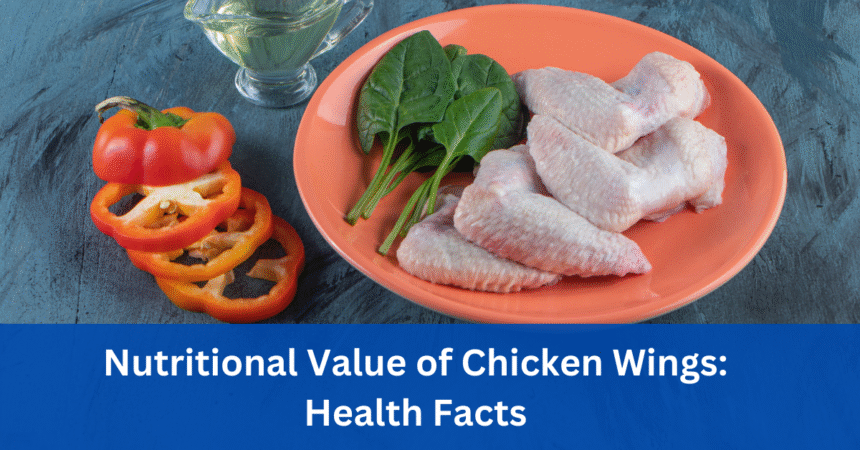Introduction
Chicken wings are one of the most popular foods worldwide. From game-day snacks to family dinners, they show up on tables in countless flavors and styles. While wings are often seen as comfort food, they also bring solid nutritional benefits—especially as a protein source. At the same time, the way they’re prepared can make a big difference in whether they’re considered a healthier option or more of an indulgence.
In this guide, we’ll break down the calories, protein, fat, and other nutrients in chicken wings. We’ll also look at the health benefits, potential drawbacks, and the impact of cooking methods. Whether you’re watching your diet, trying to eat more protein, or just curious, this article gives you the complete picture.
Nutrition in Chicken Wings
One Wing (Raw, Skin-On)
A single raw chicken wing (meat plus skin, about 20–25 grams) contains:
-
Calories: ~94
-
Protein: ~9 g
-
Fat: ~6 g (about 2 g saturated fat)
-
Carbohydrates: 0 g
-
Cholesterol: ~54 mg
-
Sodium: ~41 mg
Even though wings are small, they’re calorie-dense because of the combination of fat and protein.
100 Grams of Wings (Raw, Skin-On)
For a larger serving, 100 grams of raw wings provide:
-
Calories: 203
-
Protein: 30.5 g
-
Fat: 8.1 g
-
Carbohydrates: 0 g
Protein makes up more than half of the calories, which is a big reason wings can be part of a protein-focused diet.
Cooked Wings (Skin-On)
Cooking changes nutrition slightly because water cooks out, making nutrients more concentrated.
For a 50-gram cooked wing:
-
Calories: 96
-
Protein: 8.8 g
-
Fat: 6.4 g
-
Carbohydrates: 0 g
That means cooked wings are even more calorie-dense than raw.
How Cooking Methods Change the Nutrition
-
Grilled wings (35 g, no sauce): 93 calories, 8.1 g protein, 6.4 g fat.
-
Baked plain wings (10 pieces): Around 690 calories, 60–68 g protein, less fat than fried.
-
Fried wings with sauce (10 pieces): Can jump up to 1,600+ calories, with a lot more fat and sodium.
So while chicken wings themselves are protein-rich, the way they’re cooked determines whether they’re a lighter meal or a high-calorie splurge.
Quick Nutrition Table
| Serving / Style | Calories | Protein | Fat | Carbs | Notes |
|---|---|---|---|---|---|
| 1 raw wing (meat & skin) | 94 | 9 g | 6 g | 0 g | Small but calorie-dense |
| 100 g raw wings | 203 | 30.5 g | 8.1 g | 0 g | 64% calories from protein |
| 50 g cooked wing (skin-on) | 96 | 8.8 g | 6.4 g | 0 g | Nutrients more concentrated |
| Grilled, 35 g unsauced | 93 | 8.1 g | 6.4 g | 0 g | Lower in calories than fried |
| 10 baked plain wings | 690 | 60–68 g | Var. | ~0 g | Better choice for balance |
| 10 fried, sauced wings | 1,640 | 60–68 g | High | 10 g+ | High calorie and sodium |
Vitamins and Minerals in Wings
Chicken wings aren’t just about protein and fat. They also provide useful amounts of:
-
Niacin (Vitamin B3): Helps your body turn food into energy.
-
Phosphorus: Supports bone and teeth health.
-
Selenium: A trace mineral important for immunity and thyroid health.
-
Iron and Zinc: Help carry oxygen and support your immune system.
-
Sodium and Cholesterol: Naturally present, but levels rise when wings are fried or heavily seasoned.
Health Benefits of Chicken Wings
Rich in Protein
With more than 30 grams of protein per 100 grams, wings help with muscle repair and can keep you full for longer.
Naturally Low in Carbs
Plain chicken wings contain almost no carbs, making them a fit for low-carb and keto diets.
Micronutrient Boost
They provide selenium, niacin, and phosphorus, which are all important for overall health.
Satisfying and Filling
Protein helps keep hunger under control, which may reduce overeating when wings are eaten in moderation.
Things to Watch Out For
High Fat and Cholesterol
Compared with lean cuts like chicken breast, wings have more fat. Fried wings especially can add a lot of saturated fat.
Sodium Spikes
While plain wings aren’t too salty, restaurant wings or sauced versions can add a lot of sodium—sometimes half your daily limit in one serving.
Calorie Creep
Because wings are small, it’s easy to eat more than you realize. Ten fried wings with sauce can be over 1,600 calories, almost a full day’s worth for some people.
Chicken Wings in Different Diets
Keto and Low-Carb
They’re an excellent fit since they’re carb-free and higher in fat.
Weight Loss
Baked or grilled wings without skin are the lighter option. Fried wings or creamy sauces can make weight loss harder.
Sports Nutrition
Athletes benefit from the high protein, especially when wings are paired with healthy sides like rice or vegetables.
Everyday Balanced Diet
Wings can fit in as long as portions are controlled and cooking methods are healthier.
Tips for Making Chicken Wings Healthier
-
Choose baking, grilling, or air frying instead of deep frying.
-
Watch the sauces—opt for dry rubs or light marinades instead of heavy, sugary, or creamy coatings.
-
Control portions—don’t let small size fool you, calories add up fast.
-
Pair with healthy sides like salads or roasted veggies to balance the meal.
-
Remove the skin if you want to cut down on fat.
Conclusion
Chicken wings have earned their place as a favorite comfort food, but they’re more than just tasty. They’re packed with protein, low in carbs, and contain valuable vitamins and minerals. The key is in how you prepare and enjoy them.
When grilled or baked, wings can be a balanced part of your diet. When deep-fried and coated in rich sauces, they become more of an occasional treat. With mindful choices, you can enjoy chicken wings without guilt and still get nutritional benefits.
FAQs
Q1: How much protein is in 10 chicken wings?
About 60–68 grams, depending on the size and cooking method.
Q2: Do chicken wings have carbs?
Not naturally. Carbs come only from breading, sauces, or marinades.
Q3: Are chicken wings good for weight loss?
Yes, if they’re grilled or baked and eaten in moderation. Fried wings are much higher in calories.
Q4: Are chicken wings keto-friendly?
Yes, they’re low in carbs and contain a balance of protein and fat.
Q5: What’s the healthiest way to cook wings?
Grilling, baking, or air frying with light seasoning.





